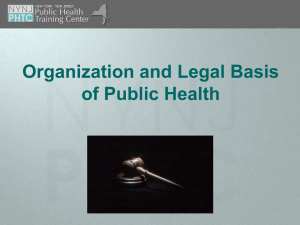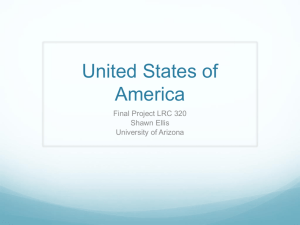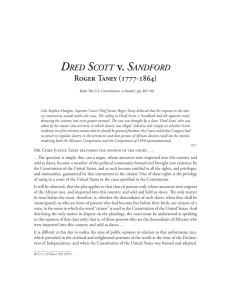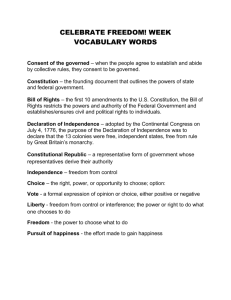Canadian Charter of Rights and Freedoms
advertisement
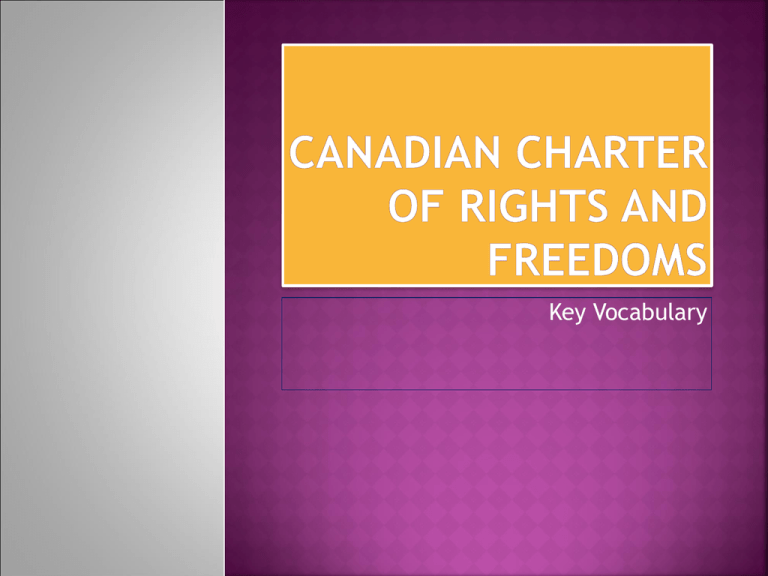
Key Vocabulary http://www.youtube.com/watch?v=Chd06XH aFgo Right Freedom Inalienable Rights Franchise Entrench Override Invoke Notwithstanding Clause Puzzle 1 Unscramble these four jumbled words, one letter to each square to form four vocabulary words. Kioven O O o o sgirth o o o Dxetritaon o o Dmofere Now arrange the circled letters to form the answer to the question below: What does constitutional law do in relation to statute law? Jumbles: Invoke Rights Extradition Freedom Answer to the Question: Overrides Fill in the numbered clues of three shorter words to help find the longer word in this “Charter puzzle” (some letters may be used more than once) A)1._2._3._4._5._6._7._8._9._10_ 2,10,1,4,-breakfast,lunch,or dinner 7,5,6,9,-viloent public disturbance 9,8,4,3-gossip B)1._2._3._4._5._6._7._8._9_ 5,6,3,7,4-bind or restrain 8,3,1,9- secure 2,3,7,8,9,-lift up Meal/riot/tale/Ameliorate Chain/safe/raise/Franchise As Canadians, we are blessed with incredible freedom. There is also a lot of hardship, evil, and more and more persecution. Examples: Crime and gangs Abortion Divorce and the redefinition of family Pornography Drugs One factor is that as a country, we have pushed God out of the public square (our courts, Parliament, etc). We have replaced God with our own standards of right and wrong. Pierre Elliott Trudeau 1982 – Charter of Rights and Freedoms Becomes part of our constitution (Constitution Act) Effectively replaces the Bill of Rights Rights, Responsibilities, and Privileges What is a right? ◦ What is a responsibility? ◦ An entitlement, that comes from someone who has the authority to give it (e.g. life). Usually it can not be taken away. Something which must be performed as an obligation or duty. Responsibilities are necessary for rights to exist (e.g. uphold the life of our neighbour). What is a privilege? ◦ A benefit that comes from a particular position which can be removed, changed, or increased (e.g. holidays). Right is a legal, moral or social claim that people are entitled to, primarily from their government.( a person accused of committing an offense is entitled to a fair trial) Freedom is a right to conduct one’s affairs without governmental interference( one has the right to seek employment in any part of Canada.) For thousand of years, people all over the world have struggled with the concept of human rights. As ideas about rights evolved and took form from different codes the same questions came up: What Rights people should have? Should rights be absolute( unrestricted)? Is everyone entitled to the same rights? What is the power of the sates in creating and enforcing laws? How can people ensure that governments do not restrict their rights and freedoms? http://www.youtube.com/watch?v=otPfwkO 0_C8 Civil rights: the rights of citizens (e.g. to political and social freedom and equality), which limit the power a government has over its citizens Human rights: rights that protect one from discrimination by other individuals and in certain areas of one’s life Natural rights: rights thought to be inherent, such as the right of all people to life, liberty, and security; rights that are independent of rulers, society and governments Inalienable rights: guaranteed entitlements that cannot be transferred from one person to another Franchise: the right to vote Entrench: to protect and guarantee a right or freedom by ensuring that it can only be changed by an amendment to the Constitution 1833 Slavery is abolished under the British Emancipation Act 1884 Indian Act is amended to outlaw cultural and religious ceremonies such as potlatch 1990 Chinese Immigration Act increases $50 head tax to $100 1900 Dominion Elections Act excludes minorities from voting in federal elections\ 1908 “No stoppage” rule requires immigrants to travel directly to Canada ,reducing the numberof immigrants from Canada 1914 Komagata Maru Incident: officials allow only 20 of the 376 potential immigrants to enter Canada,forcing the rest to return to India 1916 Manitoba grants women the right to vote in provincial elections 1918 Women are granted the right to vote in federal elections 1919 Women are allowed to stand fro Parliament 1920 Federal Government makes the franchise universal, except for some minorities and Status Indians 1921 Quebec Court upholds the right of a theatre owner to refuse to allow a black patron to sit in the orchestra seats 1927 Indian Act is amended to make it illegal for Aboriginal people to hire lawyers to pursue land claims without the consent of the superintendent general of Indian Affairs 1928Alberta passes the Sexual Sterilization Act, ordering the sterilization of patients in psychiatric hospitals 1928 Supreme Court of Canada decides that word “person” does not apply to women 1929 Famous Five –Emily Murphy, Nellie McClung, Henrietta Muir Edwards, Louise McKinney ,and Irene Parlby appeal “person decision” to the Privy Council in England, which rules that women are persons 1934 People libelled because of race or creed can get a court order to stop the libel 1940 Communist party is outlawed under the War Measures Act 1942 Hutterites, Doukobhors and enemy aliens are barred from buying land 1942 Japanese Canadians are forcibly removed from their homes and sent to detention camps 1945 Covenant Restraining the sale of land to Jews is struck down 1947 Saskatchewan Bill of Rights Act is the first broad, human rights statute passed in Canada 1948 People of all races, except for Status Indians, are given federal franchise 1950 Supreme Court of Canada rules that Jehovah’s Witnesses can distribute religious pamphlets. 1953 Fair Employment Practices Act 1956 Female Employees Equal Pay Act 1960 Status Indian are granted the right to vote in federal elections 1960 Canadian Bill of Rights 1215 Magna Carta (England) 1776 Declaration of Independence (United States) recognized that all people have natural rights and provided for individuals’ inalienable rights to equality and liberty 1789 Declaration of the Rights of Man (France) 1833 Slavery is abolished under the British Emancipation Act 1865 Slavery is abolished in the United States with the 13th amendment to the U.S. Constitution 1869 Bill of Rights (Britain) gave British parliament supremacy over the monarchy and extended certain civil and political rights such as free elections, reasonable bail and fines, and freedom from cruel or unusual punishment 1948 Universal Declaration of Human Rights (United Nations) In addition to recognizing the equal and inalienable rights of all members of the human family, it provides for fundamental freedoms of thought, opinion, expression, conscience, religion, and peaceful assembly. It also declares the equal rights of men and women, equality before the law, the right to be presumed innocent until proven guilty, education rights, and freedom from torture or inhumane punishment. 1960 The Canadian Bill of Rights 1982 Canadian Charter of Rights and Freedoms is entrenched in the Constitution Act, 1982 · Magna Carta (1215) Limited the monarch’s power American Revolution 1775-1783 13 colonies fighting for independence from Britain Laws suited Great Britain not its colonies – people were angry No elected representatives in British Parliament British ignored American demands 1776 Declaration of Independence War raged on until 1783 American Constitution became law in 1788 Did not include a Bill of Rights Feared that giving rights to common people might lead to “mob rule” 1791 – 10 amendments were made to the Constitution and became the Bill of Rights · French Revolution In the 1700s a group of French thinkers known as the philosophers wrote books and pamphlets attacking the power of the French king, nobles, and the Church. Wanted more freedom for the French people and an end to the feudal system 1789 – French people rose up to overthrow their rulers Thousands and thousands of people died Feudalism and the privileges of rulers and Church were abolished A National Assembly (similar to the House of Commons) was set up Members elected by the people August 26, 1789 Declaration of the Rights of Man and of the Citizens Abolition of Slavery Slaves continued to be legally defined as “property” not as “humans” or “citizens” Over a 300 year period 15 million people had been captured in Africa to be traded as slaves in Europe and North America Seen only as a source of labour 1833 – Slavery Abolished under the British Emancipation Act US Civil War Abraham Lincoln became president in 1861 on a platform of opposing the spread of slavery Civil war broke out (1861-1865) Northern or Union forces fought to abolish slavery Southern or Confederate forces fought to keep slavery legal Northern Forces won in 1865 13th amendment to the US Constitution abolished slavery Universal Declaration of Human Rights United Nations formed after WWII Universal Declaration of Human Rights signed on December 10, 1948 First time nations from around the world had signed a formal agreement on specific rights and freedoms for all human beings For billions of people these guarantees are unfulfilled Canadian Bill of Rights Canadian law is based on English Common law – unwritten Canadians had legal rights that were not written down but simply understood to exist After WWII, many Canadians came to believe that legal rights had to be written down John Diefenbaker became leader of the Progressive Conservative party 1957-1958 Federal election – promised a bill of rights August 10, 1960 – Canadian Bill of Rights was passed in a non-Non revolutionary method Set down legislation the rights and freedoms that Canadians already enjoyed under the common law. “Dissatisfied minority groups, corporations, criminals ,and their lawyers are the only people who have benefited from the Charter” Write an argumentative five hundred word essay ,either agreeing or disagreeing with the quote. In your essay include information about the Charter, relevant cases, and Supreme Court decisions. Assignment is due April,6

